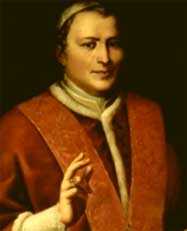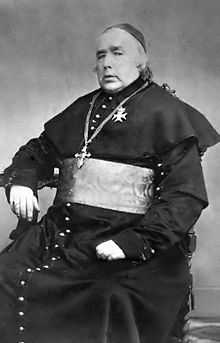Reestablishment of the episcopal hierarchy in the Netherlands

Reestablishment of the episcopal hierarchy in the Netherlands was decided in 1853 by Pope Pius IX in the apostolic letter Ex qua die arcano,[1] after the 1848 constitutional revision had made this possible. The reestablishment of the episcopal hierarchy in 1853 led to the April movement protest. The reaction of King William II of the Netherlands and the resignation of the Johan Rudolph Thorbecke cabinet confirmed the redefinition of the roles of government and King after the 1848 constitutional revision.
History
After his appointment as head of state of Spanish Empire, which included the Low Countries, Philip II of Spain in 1559 a reorganization of the dioceses in the Netherlands. The northern provinces fell under the Archdiocese of Utrecht, the southern under the Archdiocese of Mechelen. Utrecht was an archdiocese with the suffragan dioceses of Haarlem (Central and North-Holland), Middelburg (Zeeland), Deventer (Overijssel and Gelderland), Groningen (Groningen) and Leeuwarden (Friesland). Roermond and 's-Hertogenbosch were dioceses under the Archdiocese of Mechelen.
The first Archbishop of Utrecht, Frederik V Schenck van Toutenburg, was also the last. The Dutch Revolt against Spain had major implications for Catholicism in the rebellious northern Netherlands who became known as the Dutch Republic. Which favored Protestant Calvinism and imposed severe restrictions on Catholicism. In 1592 Rome declared the province of Utrecht church to mission area, called the Dutch Mission, which came to be headed by a vicar apostolic. Also, 's-Hertogenbosch later became an apostolic vicariate when normal episcopal administration was not possible after the Peace of Westphalia in 1648. Catholics were, after initial persecution, eventually tolerated, especially in the larger cities, but if they could not openly display their Catholicism. In many cities Catholics gathered for Mass in clandestine churches with had exteriors not recognizable as churches.
"some areas had archpriests dependent on the Nuncios in Cologne and Brussels"[2]
Prelude to the reestablishment
The official position of the Catholic Church in the Netherlands improved when the Batavian Republic proclaimed the separation of Church and State in 1796. The different churches came back on an equal footing. Some of the Catholic churches, which were taken by the Protestants held in the 16th century, were returned. The Catholic community began organize again; newspapers, magazines, and schools were established. However, state regulation remained, for example, wearing clerical clothing in public was not allowed and ringing of bells was banned.
The Concordat of 1801 between Napoleon Bonaparte and Pope Pius VII a number of pending issues between church and state in.[lower-alpha 1] A number of new apostolic vicariates established to prepare for a future reestablishment of the dioceses. The Diocese of Antwerp was abolished and North Brabant that since part of it was now the Apostolic Vicariate of Breda. Also the Diocese of Roermond was abolished and divided between the Diocese of Liege and the Diocese of Aachen. The last bishop of Roermond, Joannes van Velde to Melroy and Sart-Bomal, in 1801 was appointed apostolic vicar of the new vicariate Grave-Nijmegen. Also, vicariate Ravenstein Megen no longer belonged to the Diocese of Liège, but was an apostolic vicariate.
In the Kingdom of Holland the departement voor de Rooms katholieke Eredienst was founded. The king gave certain rights to intervene in the organization of the churches. In 1812, the Netherlands became part of France and the "extinction acts" (uitstervingsbesluiten) issued which prevented monasteries from accepting new members, its ultimate purpose was the elimination of the monastic orders.
The first bishops

The Concordat of 1827 between King William I of the Netherlands and Pope Leo XII about the reestablishment of the dioceses in the Netherlands reached the United Kingdom of the Netherlands.[lower-alpha 2] This concordat established two dioceses of North Netherlands, namely the diocese of Den Bosch, the provinces of North Brabant, Zeeland and Gelderland would include Archdiocese of Amsterdam and the rest of the Netherlands, with the exception of Limburg included. Limburg would be the province of Liege, the diocese of Liège form suffragan to the Archdiocese of Mechelen. The concordat had even provided a fully developed cathedral on Nieuwmarkt square in Amsterdam. However, including the Belgian Revolution this could not be done. William I moreover confirmed the earlier restrictions on the monasteries were imposed, and the Protestant politicians were not unanimously in favor of a restored Catholic hierarchy. However, in 1833 a suffragan bishop was appointed for the Dutch Mission. Although Bishop Cornelis van Wijckerslooth had no diocese, he had all the powers of a bishop, as the administration of confirmation, ordaining priests and churches.
When Treaty of London (1839) established the border between the Kingdom of Belgium and the Kingdom of the Netherlands, Dutch Limburg was an apostolic vicariate, led by Joannes Paredis , who was consecrated bishop in 1841. A real restoration of the dioceses in the Netherlands seemed too early, and negotiations on the implementation of the Concordat of 1827 failed "from the start on account of the intransigence of the Protestants."[2] Nevertheless, there was a compromise, two southern vicars, Joannes van Hooydonk in Breda and Henricus den Dubbelden in 's-Hertogenbosch, were consecrated as bishop in 1842. In the same year, Joannes Zwijsen was appointed bishop, who was on board the vicariates Grave-Nijmegen and Ravenstein Megen. This last appointment was made, it seems, after direct personal intervention of William II. William II was favorably disposed towards the Catholics and among other things, put an end to restrictive legislation for the monasteries.
In 1847 also left a number of prominent Roman Catholics themselves heard and called for a normalization of the ecclesiastical administration in the Netherlands. Their petition was supported by Wijckerslooth and the bishop of Liege, Cornelius Richard Anton van Bommel . The last restrictions on the Catholics were removed in the 1848 constitutional revision. The decision was made at a meeting of the Congregation for the Propagation of the Faith in December 1852. Pope Pius IX approved the plan, and in 1853 it was implemented. This was the archpriest shelves in the north and the apostolic vicariates raised in the south. Zwijsen was appointed archbishop of the reestablished episcopal hierarchy in the Netherlands. Then the Roman Catholic Church was reorganized into one archdiocese, Utrecht, with four suffragan diocese, Haarlem-Amsterdam, 's-Hertogenbosch, Breda and Roermond. In honor of Willibrord, the archiepiscopal see was established in Utrecht. Only in 1956 were the dioceses of Groningen-Leeuwarden and Rotterdam founded.
In 1853 about 1.2 million people were Catholic, constituting about one-third of the Netherlands' population, living mostly in the provinces of Limburg and North Brabant.[2]
Notes
- ↑ See "Napoleon's concordat (1801): text". concordatwatch.eu. Translated from the French by Muriel Fraser. Archived from the original on 2014-07-07. Retrieved 2014-07-07. Translated from "Convention entre sa Sainteté Pie VII, et le Gouvernement français". napoleon.org (in French). Fondation Napoléon. 2008. Archived from the original on 2009-01-08.
- ↑ See "Convention and accord between Pope Leo XII and William I, King of Belgium and the Netherlands". concordatwatch.eu. Translated from the Dutch by Ilonka Nagy. Archived from the original on 2013-05-11. Retrieved 2014-03-11. Translated from "Het Concordaat van 1827". rorate.com (in Dutch). Translated from the Latin by De Secretaris der Permanente Commissie, uit den Raad van State voor de Zaken van de R.C. Eeredienst. 2003-08-20. Archived from the original on 2013-06-17. Retrieved 2014-03-11. Translated from Pacca, Bartolomeo (1903) [concluded 1827-09-16]. "Conventio Inter Sanctissimum Dominum Leonem XII, Summum Pontificem, et Serenissimum Guilielmum I, Belgarum regem". In Albers, Petrus H. Geschiedenis van het herstel der hiërarchie in de Nederlanden (in Dutch). Nijmegen, NL: Malmberg. pp. 534–545. OCLC 38329195.
References
- ↑ Pope Pius IX (1853-03-04). Martinis, Raffaele de, ed. "Ex qua die arcano". Iuris pontificii de propaganda fide: pars prima, complectens bullas, brevia acta S.S. a congregationis institutione ad praesens iuxta temporis seriem disposita (in Latin) (Romae: Ex Typographia Polyglotta, published 1894) 6 (1): 158–161. OCLC 3342505. Translated in "XIIIb: the apostolic letters of the most holy Lord Pius IX, by Divine Providence, pope, by which letters the episcopal hierarchy was re-established in Holland". Further papers regarding the relation of foreign states with the Court of Rome: presented to the House of Commons by command of Her Majesty, in pursuance of their address of June 14, 1853. London: Harrison and Son. 1853. pp. 61–65. OCLC 80498785.
- ↑ 2.0 2.1 2.2 "The hierarchy in Holland". The Tablet (London). 1953-05-16. p. 20. Archived from the original on 2014-02-01. Retrieved 2014-07-07.
Further reading
- Peijnenburg, Johannes W. M. (1996). Joannes Zwijsen, bisschop: 1794-1877. Bijdragen tot de geschiedenis van het Zuiden van Nederland (in Dutch). Tilburg: Stichting Zuidelijk Historisch Contact. ISBN 9789070641542.
- Sengers, Erik (2003). "Al zijn we katholiek, we zijn Nederlanders": opkomst en verval van de katholieke kerk in Nederland sinds 1795 vanuit rational choice perspectief (ETD) (in Dutch). Utrecht: Katholieke Theologische Universiteit te Utrecht. ISBN 9051669658.
- "Geschiedenis van het Nederlands katholicisme". ru.nl/kdc (in Dutch). Nijmegen: Radboud University Library. Catholic Documentation Centre. Retrieved Jan 2007.